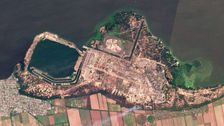KYIV, Ukraine (AP) — Authorities began distributing iodine tablets to residents near Ukraine’s Zaporizhzhia nuclear power plant Friday in case of a radiation leak, amid mounting fears that the fighting around the complex could trigger a catastrophe.
The move came a day after the plant was temporarily knocked offline because of what officials said was fire damage to a transmission line. The incident heightened dread of a nuclear disaster in a country still haunted by the 1986 explosion at Chernobyl.
Advertisement
Continued shelling was reported in the area overnight, and satellite images from Planet Labs showed fires burning around the complex — Europe’s biggest nuclear plant — over the last several days.
Iodine tablets, which help block the absorption of radioactive iodine by the thyroid gland in a nuclear accident, were issued in the Ukrainian-controlled city of Zaporizhzhia, about 45 kilometers (27 miles) from the plant. A woman and her small daughter were among those receiving the pills.
AP Photo/Andriy Andriyenko
The U.N.’s atomic energy agency has been trying to send a team in to inspect and help secure the plant. Officials said preparations for the trip were underway, but it remained unclear when it might take place.
Advertisement
The Zaporizhzhia plant has been occupied by Russian forces and run by Ukrainian workers since the early days of the 6-month-old war. The two sides have repeatedly accused each other of shelling the site.
In Thursday’s incident, Ukraine and Russia blamed one another for the transmission-line damage that knocked the plant off the power grid.
Planet Labs PBC via AP
Exactly what went wrong was not clear, but Ukrainian President Volodymr Zelenskyy said the plant’s emergency backup diesel generators had to be activated to supply electricity to operate the complex.
The plant requires power to run the reactors’ vital cooling systems. A loss of cooling could lead to a nuclear meltdown.
Advertisement
Ukrenergo, Ukraine’s transmission system operator, reported Friday that two damaged main lines supplying the plant with electricity had resumed operation, ensuring a stable power supply.
The country’s nuclear power agency, Energoatom, said the plant had been reconnected to the grid and was producing electricity “for Ukraine’s needs.”
“The nuclear workers of Zaporizhzhia power plant are real heroes! They tirelessly and firmly uphold the nuclear and radiation safety of Ukraine and the whole of Europe on their shoulders,” the agency said in a statement.
Russia-installed officials in the Zaporizhzhia region, however, said that the plant was supplying electricity only to Russia-controlled areas of the country and not the rest of Ukraine.
Concerns about the site have reverberated across Europe.
French President Emmanuel Macron said a visit by the U.N.’s International Atomic Energy Agency should be allowed to take place “very quickly,” warning: “Civilian nuclear power must not be an instrument of war.”
Advertisement
AP Photo/File
Lana Zerkal, an adviser to Ukraine’s energy minister, told Ukrainian media that the logistics for an IAEA visit were still being worked out. Zerkal accused Russia of trying to sabotage the visit.
Ukraine has claimed Russia is using the plant as a shield by storing weapons there and launching attacks from around it. Moscow, for its part, accuses Ukraine of recklessly firing on the place.
Zaporizhzhia’s reactors are protected by thick, reinforced concrete containment domes that experts say can withstand an errant artillery shell. Many of the fears center instead on a possible loss of the cooling system, and also the risk that an attack on the cooling ponds where spent fuel rods are kept could scatter radioactive material.
Continued Russian shelling of Nikopol, a city across the Dnieper River from the Zaporizhzhia plant, damaged 10 houses, a school and a health care facility but caused no injuries, Dnipropetrovsk Gov. Valentyn Reznichenko said.
Advertisement
Related posts:
Views: 0
 RSS Feed
RSS Feed

















 August 28th, 2022
August 28th, 2022  Awake Goy
Awake Goy 



 Posted in
Posted in  Tags:
Tags: 
















